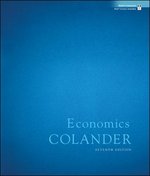Question
You are an economist working for the Congressional Budget Office (CBO). You receive a letter from the chair of the Senate Budget Committee: Dear CBO
You are an economist working for the Congressional Budget Office (CBO). You receive a letter from the chair of the Senate Budget Committee: Dear CBO Economist: Congress is about to consider the president's request to cut all taxes by 10%. Before deciding whether to endorse the request, my committee would like your analysis. How would the tax cut affect the economy of the country in the short run and in the long run?
Part II: Use analysis from Mankiw's Chapters 10 and 12 to explain how the economy adjusts over time from the short run to the long run. More specifically, assuming that the Fed does not intervene in the economy:
(e) What is the economic variable that links the short run and long run? What happens to this key economic variable over time given the above fiscal policy?
(f) Draw the aggregate demand and the corresponding aggregate supply curves in the short run and in the long run. Show the changes implied by this policy in the short run and in the long run. Be sure to show the path the economy takes in the long run.
(g) What is the effect of the change in the key variable you found in item (e) on real money balances? What happens to the LM curve? Draw this effect on the IS-LM diagrams.
(h) What is the final effect in the long run on interest rates? And on income and output? And on prices?
(i) Comparing with your answer from question 2, explain the differences between the effects of fiscal and monetary policy on real interest rates and real output in the short run and in the long run.
Step by Step Solution
There are 3 Steps involved in it
Step: 1

Get Instant Access to Expert-Tailored Solutions
See step-by-step solutions with expert insights and AI powered tools for academic success
Step: 2

Step: 3

Ace Your Homework with AI
Get the answers you need in no time with our AI-driven, step-by-step assistance
Get Started


